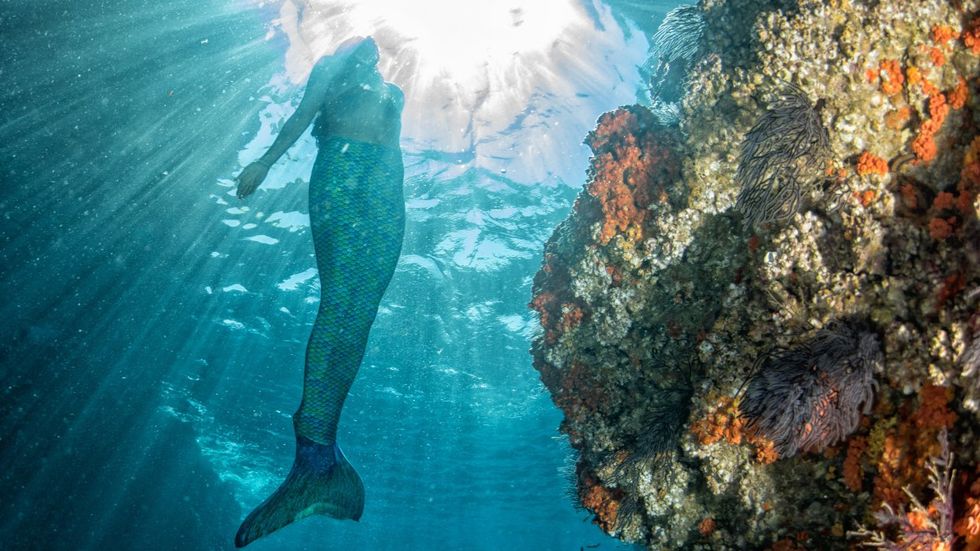
Shutterstock
With the reimagined Little Mermaid hitting Disney+, it's a perfect time to remember sea beauties have long been immortalized in cultures around the world.
September 11 2023 4:08 PM EST
September 11 2023 4:20 PM EST
By continuing to use our site, you agree to our Private Policy and Terms of Use.

With the reimagined Little Mermaid hitting Disney+, it's a perfect time to remember sea beauties have long been immortalized in cultures around the world.
Disney’s live-action filmThe Little Mermaid arrived this September arrived this September on its streaming platform. Since its announcement last year, the film, starring Grammy Award-winning artist Halle Bailey, has received a lot of negative feedback with the casting of her, a young Black woman, as the lead character, Ariel. Many bemoaned and howled that casting a Black star originally animated as a red-headed white female was ridiculous. From the hashtag #NotMyAriel to threads using pseudo-science to explain the improbability of a Black mermaid, the backlash from Bailey’s casting was extreme, if not discomforting. Though the film takes cues from its 1989 film, sourced from the works of a 19th-century Danish writer, one has to remember that the mermaid figure is not limited to one culture, race, or ethnic group. Instead, they symbolize our collective stories and diverse perspectives.
Mermaids have captivated civilizations since the dawn of time. The earliest recorded figure was Atargartis, a half-human, half-fish goddess worshipped by the ancient Sumerians, who represented fertility and embodied the dual nature of water — life-giving and destructive. Like many earlier deities, Atagartis would be identified with and praised in other names and forms from ancient Greece (Aphrodite) to Rome (Venus).
Across Asia, mermaids also pop up in many myths and folklore. In India, the Nagini were sensual creatures associated with protection and fertility, on par with their Sumerian, Greco-Roman, and other Western equivalents. Several stories emerge from Chinese sources: Shan Hai Jing of the 4th century BCE recalls the lingyu having a human’s face with a fish’s body. These four-footed creatures could resurrect themselves and emit a sound like crying babies. Feng Yi, meanwhile, was the half-human, half-fish god of the Yellow River. Interestingly, a famous novel from the Qing dynasty has a similar tone to the Disney plot: Liao Zhai Zhi Yi tells the story of a lovable mermaid named Bai Qiulian who becomes a human to marry the son of a businessman.
In the West African region of Yorubaland, Yemọja holds significant cultural and spiritual importance as Queen of the Orishas (spirits). Depicted as a mermaid, she has domain over all forms of water, women, and children. Like Atargartis, Yemọja took on different names and identities — though, sadly, by chains. The convergence of African, Indigenous, and European cultural identities via the Trans-Atlantic slave trade preserved the mermaid figure through storytelling and religion in the Caribbean. Yemọja became the Catholic Our Lady of Navigators; in the syncretic beliefs that emerged from this region — Santeria, Haitian Vodou, Candomblé, and Umbanda — she went by the names Yemanja, Mami Wata, Yemaya, and La Sirène. To this day, Yemọja remains a popular figure across the diaspora, with significant holidays dedicated to her across Latin America and the Caribbean. Writing as an Afro-Caribbean trans woman, Yemọja also remains as much a personal source of inspiration and hope as a guardian for the disenfranchised and marginalized.
The mermaid figure has transcended geographical and cultural boundaries in these tales, assuming many identities. It is a testament to the universality of our shared human experience. By rethinking the narrative around The Little Mermaid, perhaps it is an opportunity to review standards surrounding other issues such as sexuality and gender. The movie itself focuses on a character who, despite being assigned to a particular life and set of rules, desires to break free from them and find a life full of love, freedom, and authenticity — something that resonates with many in the LGBTQ+ community.
The expansive nature of mermaids — protective, alluring, maleficent, or benevolent — can give us a canvas for the spectrum of gender and sexual identities. By examining the mermaid figure and folklore, we can move beyond the binary notions of gender and sexuality and open the door to a broader, more nuanced — dare I say, fluid — understanding of the human experience.
Whether we read folktales or (re)watch the latest film, let us not narrow our perspectives of the mermaid figure and, equally, narrow definitions of race, culture, gender, or sexuality. Instead, let us appreciate mermaids’ rich and diverse history and how it binds the even richer tapestry of humankind, embracing each culture’s unique stories. With these many tales and undoubtedly more, we can better understand our shared humanity and, ultimately, work towards a more inclusive world.
Marie-Adélina de la Ferrière is the public relations specialist at equalpride, publisher of Out and Out.com.
Views expressed in Out’s opinion articles are those of the writers and do not necessarily represent the views of Out or our parent company, equalpride.
Marie-Adélina de la Ferrière is the Community Editor at equalpride, publisher of The Advocate, Out, Out Traveler, Plus, and Pride.com. A Haitian-American trans woman, she tirelessly champions voices from the LGBTQ+ community, creating a vibrant community engagement approach that infuses each story with a dynamic and innovative perspective. Like and follow her on social: @lovabletransauntie.
Marie-Adélina de la Ferrière is the Community Editor at equalpride, publisher of The Advocate, Out, Out Traveler, Plus, and Pride.com. A Haitian-American trans woman, she tirelessly champions voices from the LGBTQ+ community, creating a vibrant community engagement approach that infuses each story with a dynamic and innovative perspective. Like and follow her on social: @lovabletransauntie.